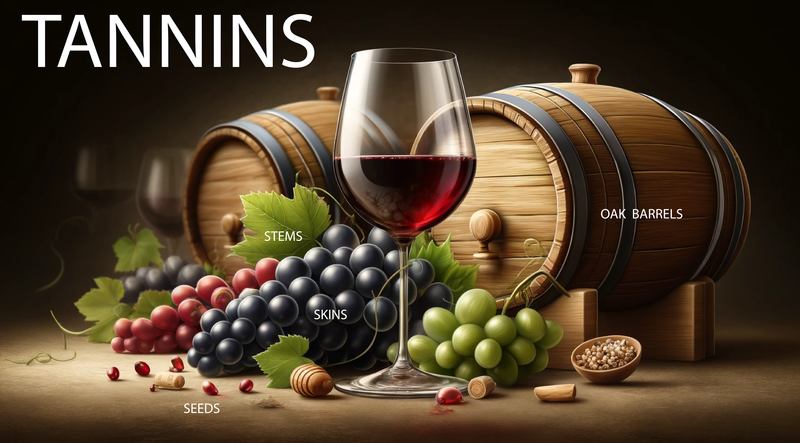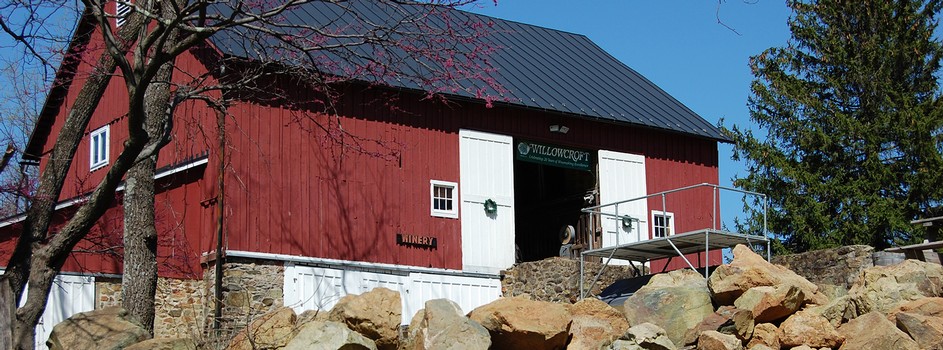🍷 Delving Deep into Tannins: The Backbone of Wine Complexity
 Tannins are one of the most critical yet misunderstood components in wine. These naturally occurring compounds found in grape skins, seeds, and stems, and not to forget, oak barrels, play a pivotal role in defining the structure, flavor, and aging potential of wine. Here, we'll explore the intricate world of tannins, their origins, impacts, and how they differ across various types of wine.
Tannins are one of the most critical yet misunderstood components in wine. These naturally occurring compounds found in grape skins, seeds, and stems, and not to forget, oak barrels, play a pivotal role in defining the structure, flavor, and aging potential of wine. Here, we'll explore the intricate world of tannins, their origins, impacts, and how they differ across various types of wine.
Understanding the Origins of Tannins
- Grape Skins: This is the main source of tannins in wine, especially reds. The grape's skin contains high levels of tannins, which are extracted during the maceration process when the juice is in contact with the skin to gain color and flavor.
- Stems and Seeds: While often removed before fermentation to prevent excessive tannin levels, some winemakers include stems and seeds in the winemaking process. This technique is particularly common in the production of Pinot Noir and other wines that benefit from additional structure and complexity.
- Oak Barrels: Oak tannins are introduced through aging in oak barrels. These tannins can add an extra layer of complexity and are typically more subtle than those derived from grapes. The use of new versus older barrels impacts the intensity of oak tannins imparted.
The Impact of Tannins on Wine
- Texture and Mouthfeel: Tannins are responsible for the astringent, mouth-drying sensation in wine. This texture is crucial for the overall balance of the wine, providing a counterpoint to sweetness, acidity, and fruitiness.
- Aging Potential: Wines with higher tannin levels generally have a greater aging potential. As wine ages, tannins polymerize and precipitate out, leading to a smoother texture and more rounded flavors.
- Food Pairing: Tannins are natural partners to rich, fatty foods. They interact with proteins and fats, cleansing the palate between bites. This is why robust tannic wines are often recommended with meat dishes, where they can cut through the richness effectively.
Variations of Tannins in Wines
- Red Wines: Red wines typically exhibit higher tannin levels due to the extended contact of the juice with grape skins and seeds during fermentation. Wines made from grapes like Cabernet Sauvignon, Syrah, and Nebbiolo are particularly known for their high tannin content.
- White Wines: Most white wines have significantly lower tannin levels since they are rarely fermented with their skins. However, some winemakers use oak aging to impart tannins subtly, adding complexity to the wines. Notably, barrel-fermented or aged Chardonnays may display these characteristics.
- Influence of Winemaking Techniques: The winemaker’s choices, from the type of grape to the time of harvest and the aging process, all dictate the tannin structure in the final product. For instance, grapes picked at optimal ripeness will generally exhibit well-integrated tannins and less harsh than those picked too early.
By understanding tannins, you can better appreciate their role in your favorite wines and make more informed choices about what you enjoy drinking and serving. Next time you pick up a glass of red, consider the tannins and how they enhance the overall experience of your wine.
Join us at Willowcroft Farm Vineyards to explore the fascinating world of wine tannins. Understanding tannins will elevate your appreciation and enjoyment of every sip, whether you're a seasoned aficionado or a curious newcomer.

